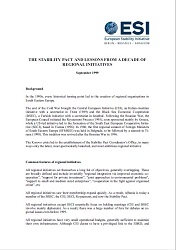THE STABILITY PACT and Lessons from a Decade of Regional Initiatives
THE STABILITY PACT and Lessons from a Decade of Regional Initiatives
Author(s): Gerald Knaus, Marcus Cox, Minna Järvenpää
Subject(s): Civil Society, Wars in Jugoslavia
Published by: ESI – European Stability Initiative
Summary/Abstract: In the 1990s, every historical turning point led to the creation of regional organisations in South Eastern Europe.
The end of the Cold War brought the Central European Initiative (CEI), an Italian-Austrian initiative with a secretariat in Triest (1989) and the Black Sea Economic Cooperation (BSEC), a Turkish initiative with a secretariat in Istanbul. Following the Bosnian War, the European Council initiated the Royaumont Process (1995), soon sponsored mainly by Greece, while a US-led initiative led to the formation of the South East European Cooperative Initiative (SECI), based in Vienna (1996). In 1988, the first regional summit of Foreign Ministers of South Eastern Europe (SFMSEE) was held in Belgrade, to be followed by a summit in Tirana (1990). This tradition was revived after the Bosnian War in 1996. The Kosovo crisis led to the establishment of the Stability Pact Coordinator’s Office, in many ways only the latest, most spectacularly launched, and most ambitious regional initiative.
Series: ESI Discussion Papers
- Page Count: 6
- Publication Year: 1999
- Language: English
- Content File-PDF

